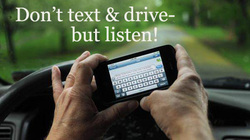Don't Text & Drive - But Listen

It's become common enough that there are public service announcements about it: don't text and drive. Why would anyone think they could do that? Isn't "eyes on the road" the first rule of driving? (Well, maybe put the key in the ignition comes first.)
Seriously, there are a lot of distractions when we drive. Not when we start out. When we first learn to drive, it's both hands on the wheel, radio off, adjust the mirrors, inch - jerk - the car forward, be made more nervous by the faces the driving instructor is making, and finally get some experience.
Pretty soon, though, we're focusing on things other than the mechanics of driving. That's too easy. So the radio's on. And we're eating a sandwich. And we're talking on the phone.
And now there's texting. Some people say they have eyes in the back of their heads, but they can't do two things at once. One hand on the wheel and one hand on the keypad doesn't work. And ask any touch typist - every once in a while you have to look at the keyboard or tyi wbs yo - you end up - typing a letter off.
Along with the "don't text and drive" campaign, safety officials are pushing another - don't talk on the phone while driving - get a hands-free device.
This one may seem a bit too much. What's the difference between an earpiece/bluetooth/speaker phone and holding the cell phone to your ear?
And yet, we see people driving with phones to their ear who are almost as distracted as the text-drivers. Strange, but bluetooth your conversation, and you can focus on the road - just like talking to someone in the next seat. Put the phone to your ear - you're in distraction land.
Why? Because the hand and eye go together, (hand-eye coordination) but hearing stands alone.
There's a lesson here: What the eye sees, the hand takes. And the hand is an extension of the heart, as stated (Numbers 15:39) "Don't go astray after your hearts and after your eyes." Sight and touch are partners - for good or for the opposite.
Of course, hearing can be turned positive or negative as well: we can listen to words of knowledge or to gossip. We can hear the words of prayer as we speak them aloud, softly to ourselves or we can hear the words of quarrel as we shout and hurl them at another.
But there's a special connection between sight and touch. We spend a lot of time as infants working on that connection. And it holds us in good stead - not just having an "eye for the ball" - but on the road.
As we "drive through life", let's keep our hands on the wheel of performing good deeds and our eyes on the road for opportunities to learn. And on this journey, I’ll bet you we can listen to the words of prayer - without being distracted.
Seriously, there are a lot of distractions when we drive. Not when we start out. When we first learn to drive, it's both hands on the wheel, radio off, adjust the mirrors, inch - jerk - the car forward, be made more nervous by the faces the driving instructor is making, and finally get some experience.
Pretty soon, though, we're focusing on things other than the mechanics of driving. That's too easy. So the radio's on. And we're eating a sandwich. And we're talking on the phone.
And now there's texting. Some people say they have eyes in the back of their heads, but they can't do two things at once. One hand on the wheel and one hand on the keypad doesn't work. And ask any touch typist - every once in a while you have to look at the keyboard or tyi wbs yo - you end up - typing a letter off.
Along with the "don't text and drive" campaign, safety officials are pushing another - don't talk on the phone while driving - get a hands-free device.
This one may seem a bit too much. What's the difference between an earpiece/bluetooth/speaker phone and holding the cell phone to your ear?
And yet, we see people driving with phones to their ear who are almost as distracted as the text-drivers. Strange, but bluetooth your conversation, and you can focus on the road - just like talking to someone in the next seat. Put the phone to your ear - you're in distraction land.
Why? Because the hand and eye go together, (hand-eye coordination) but hearing stands alone.
There's a lesson here: What the eye sees, the hand takes. And the hand is an extension of the heart, as stated (Numbers 15:39) "Don't go astray after your hearts and after your eyes." Sight and touch are partners - for good or for the opposite.
Of course, hearing can be turned positive or negative as well: we can listen to words of knowledge or to gossip. We can hear the words of prayer as we speak them aloud, softly to ourselves or we can hear the words of quarrel as we shout and hurl them at another.
But there's a special connection between sight and touch. We spend a lot of time as infants working on that connection. And it holds us in good stead - not just having an "eye for the ball" - but on the road.
As we "drive through life", let's keep our hands on the wheel of performing good deeds and our eyes on the road for opportunities to learn. And on this journey, I’ll bet you we can listen to the words of prayer - without being distracted.

